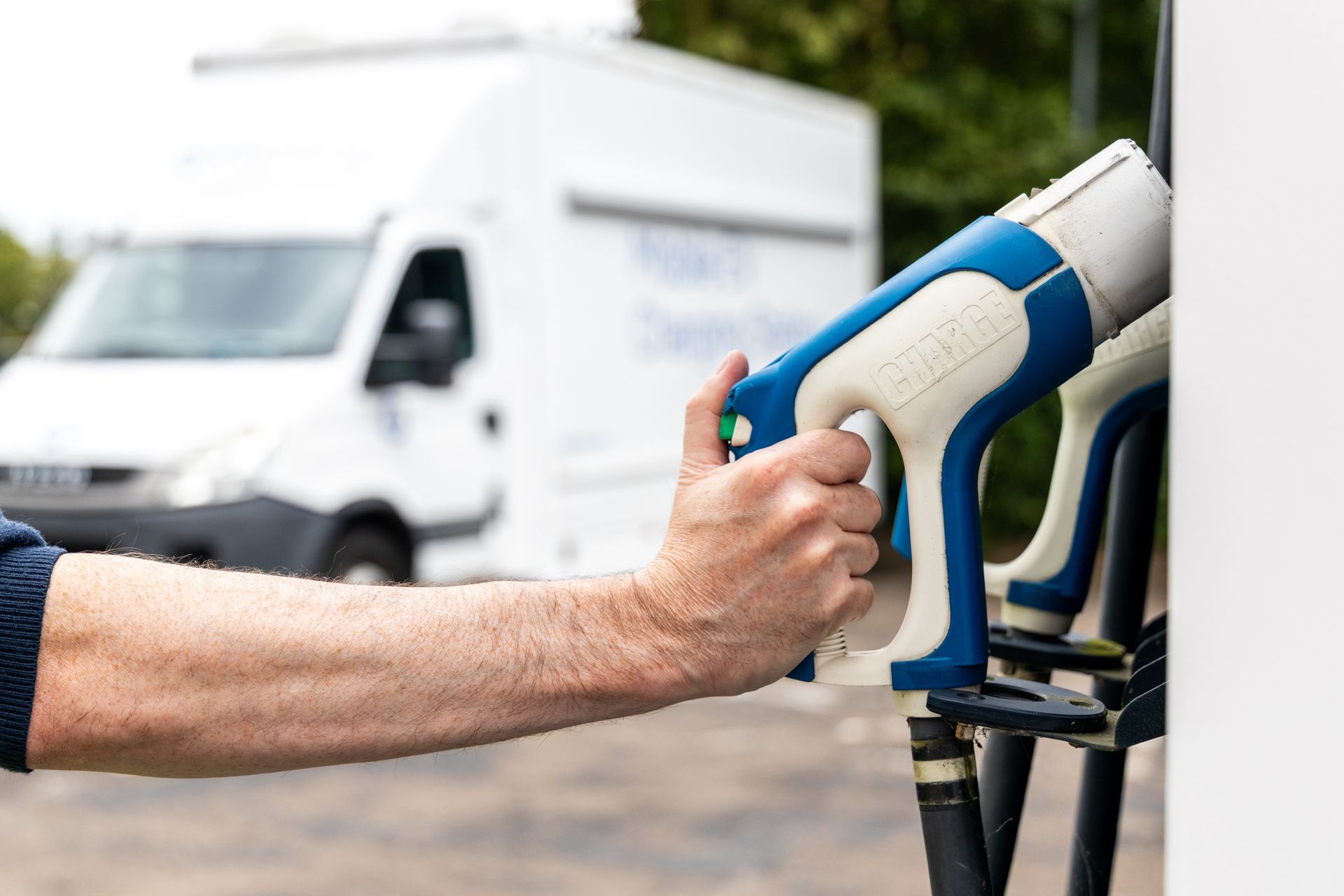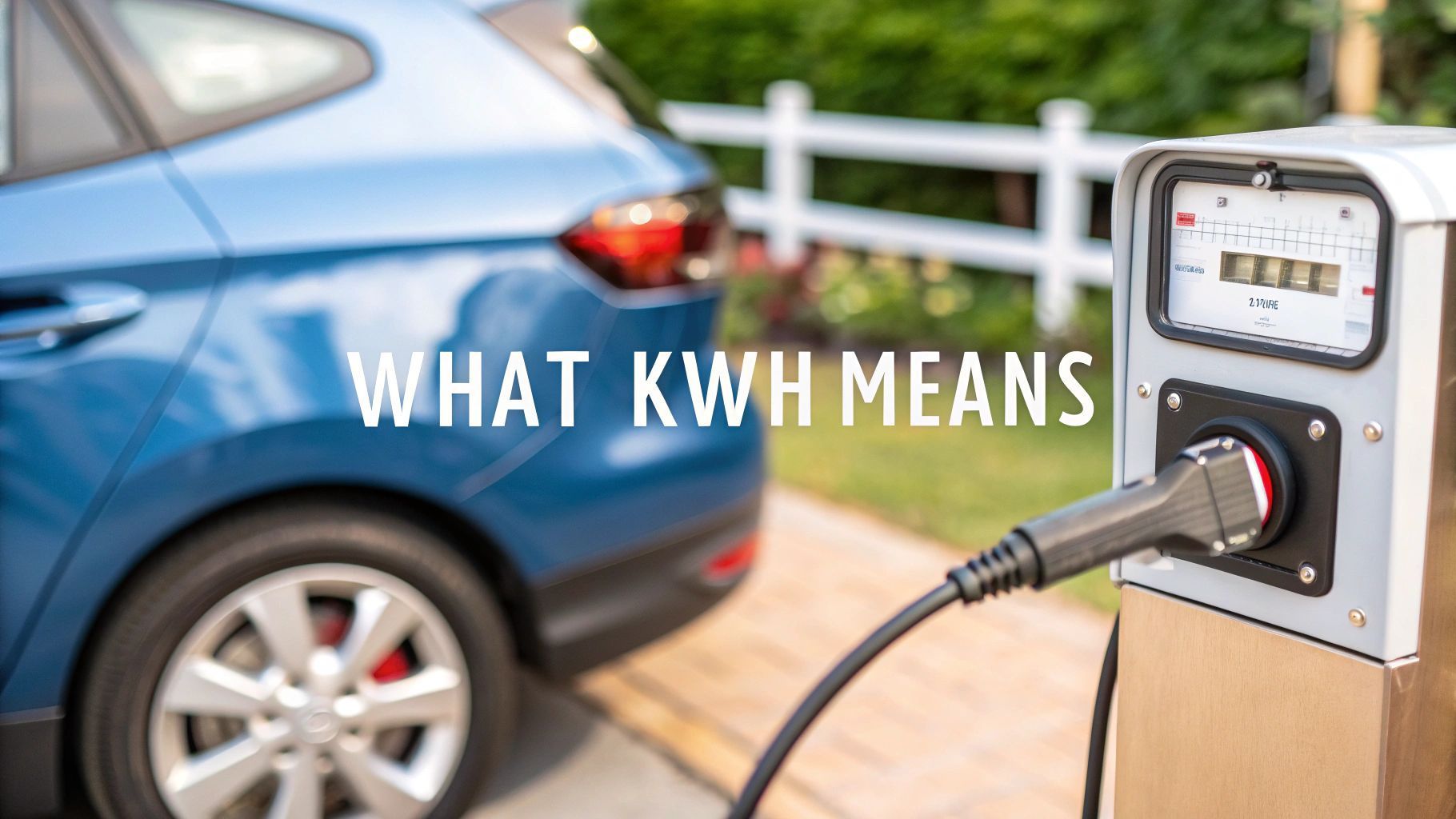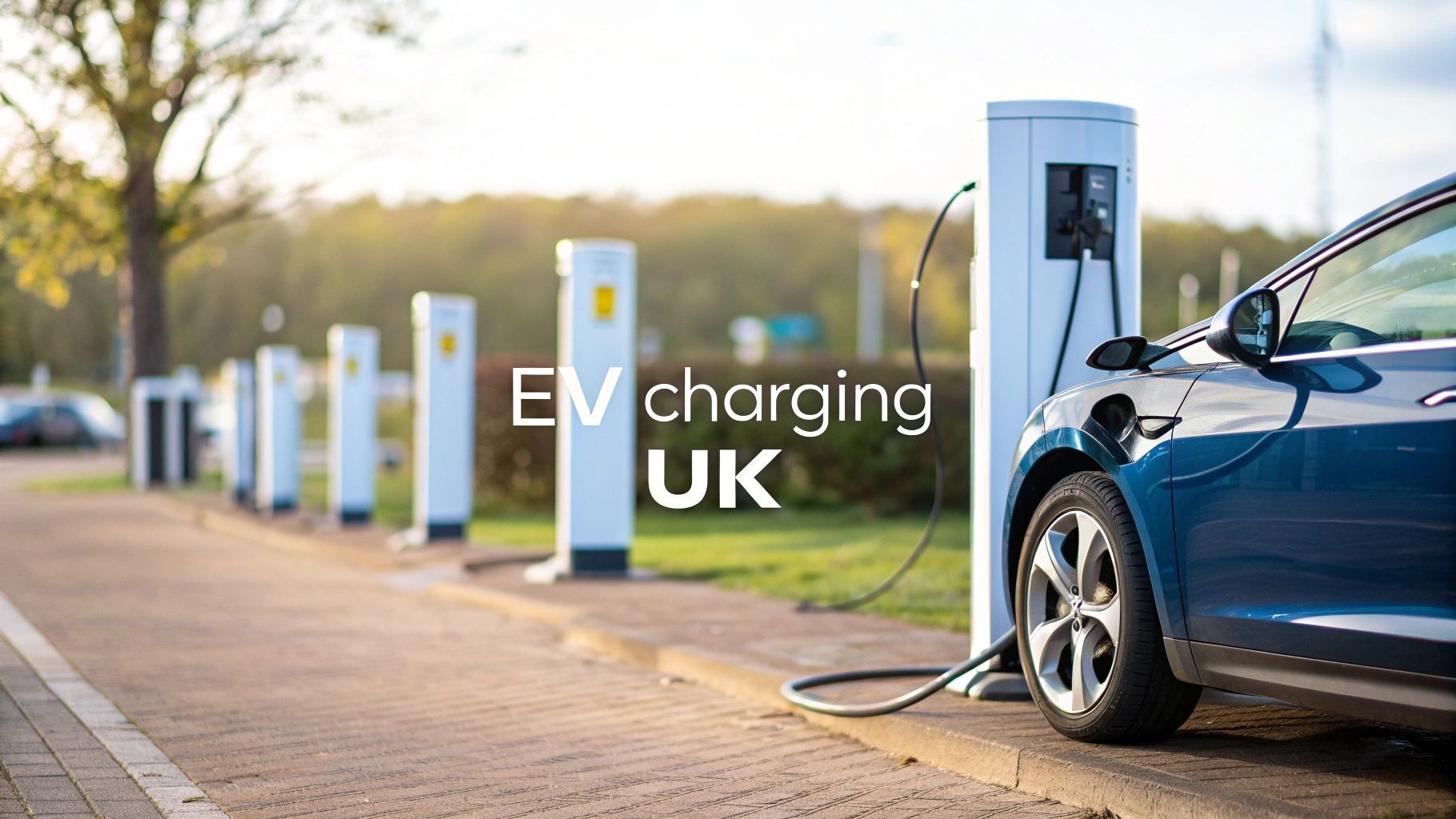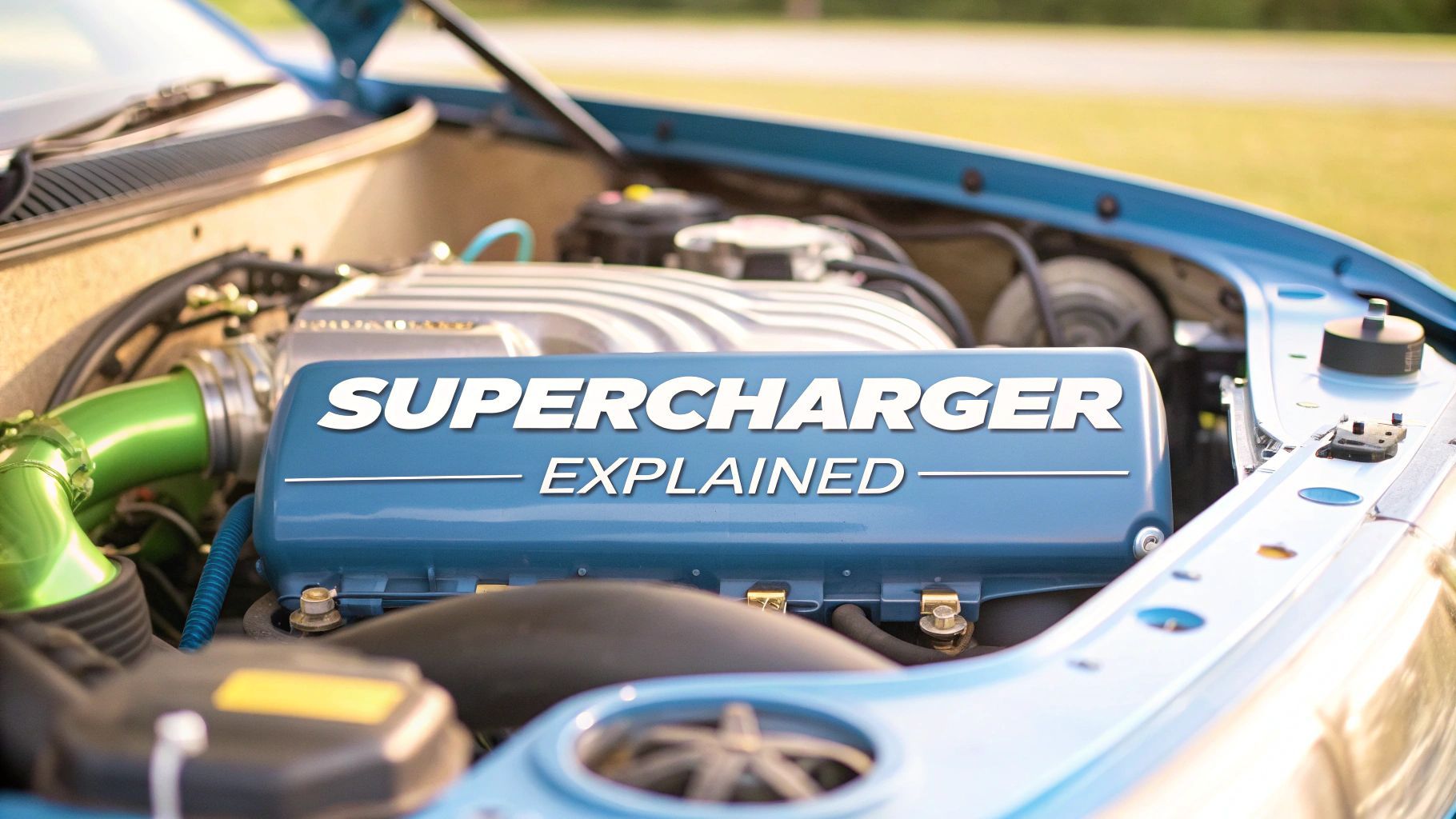How to Calculate a Kilowatt Hour
To get your head around calculating a kilowatt-hour, it's pretty simple: you just multiply the device's power in kilowatts (kW) by the number of hours you've had it switched on. This unit of energy, the kWh , is what your electricity supplier uses to bill you so understanding it is the first step to getting a grip on your costs.
What a Kilowatt-Hour Actually Is
Before we jump into the sums, it helps to properly understand what a kilowatt-hour really represents.
Think of it like filling a bucket with water. A kilowatt (kW) measures power—that's the rate at which energy is flowing, a bit like how fast the tap is running. The hour is just how long you leave the tap on. So, a kWh is the total amount of energy you've used up, or the total amount of water in the bucket.
Run a 1,000-watt (or 1 kW ) appliance for a full hour and you've used exactly one kilowatt-hour.
This measurement pops up everywhere, from your home energy bill to the specs on an EV charger. Getting comfortable with it helps answer all sorts of practical questions:
- How much does it really cost to boil the kettle three times a day?
- What’s the weekly damage for charging my electric car?
- Is that ancient telly in the spare room racking up a huge bill on standby?
The Core Formula Explained
The formula itself is refreshingly straightforward: Watts × Hours ÷ 1,000 = kWh .
You have to divide by 1,000 to convert the smaller unit, watts, into the bigger unit, kilowatts. For example, a 100-watt light bulb left on for 10 hours uses exactly 1 kWh of energy. It’s amazing how quickly these things add up.
According to Ofgem, the typical UK home gets through around 2,700 kWh of electricity each year. With suppliers charging per kWh, every single unit counts.
A kilowatt (kW) is a measure of power, like the speed of a car. A kilowatt-hour (kWh) is a measure of energy consumed over time, like the total distance travelled.
This isn’t just about trimming household bills; it's fundamental for business opportunities too. For anyone operating mobile EV chargers, knowing precisely how to calculate a kilowatt-hour is vital for setting prices and figuring out profitability.
If you’re new to these concepts, our comprehensive EV charging glossary is a great place to get up to speed with all the terminology.
Applying The kWh Calculation Formula
Let's put the theory into practice and walk through how the kilowatt-hour formula works in the real world. Getting your head around how to calculate a kilowatt hour is absolutely vital if you're running a mobile EV charging business—it’s the foundation of your costs and pricing structure.
The process is surprisingly simple. First, you need to convert an appliance's power from watts (W) into kilowatts (kW). Because there are 1,000 watts in one kilowatt , you just divide the wattage by 1,000. So, a 7,000-watt mobile charger is simply 7 kW . Easy.
Once you have that kilowatt figure, you multiply it by the time the charger was running, in hours. If that 7 kW charger is used for two hours, the calculation is 7 kW × 2 hours = 14 kWh . It’s that straightforward.
This infographic helps visualise the key steps for monitoring power and energy.
As the image shows, using a digital meter is a brilliant way to get precise, real-time data for your energy calculations, which helps keep your billing spot-on.
Examples in Mobile Charging
To build your confidence, let's run through a couple of common scenarios you'd encounter with a mobile charging service.
- A quick top-up: You get a call-out and use a 22 kW rapid charger for 30 minutes (which is 0.5 hours). The total energy delivered is 22 kW × 0.5 hours = 11 kWh .
- A standard charge: The next customer needs a more significant charge, so you hook up a 7 kW unit and run it for three hours straight. That delivers 7 kW × 3 hours = 21 kWh .
The kWh calculation is a precise process; learning about effective operating procedures can help ensure you follow each step correctly for accurate results every single time.
Key Takeaway: The one formula you need to remember is: Power (kW) × Time (hours) = Energy Consumed (kWh) . This is the cornerstone of billing for mobile EV charging services and keeping tabs on your own energy costs.
Mastering this calculation allows you to figure out the exact cost of electricity for each job. From there, you can set profitable rates and get a crystal-clear picture of your margins.
From kWh to Real Pounds and Pence
Knowing how many kWh an appliance uses is one thing but translating that into pounds and pence is where it really hits home. This is where you connect the theory of how to calculate a kilowatt hour directly to your bank balance.
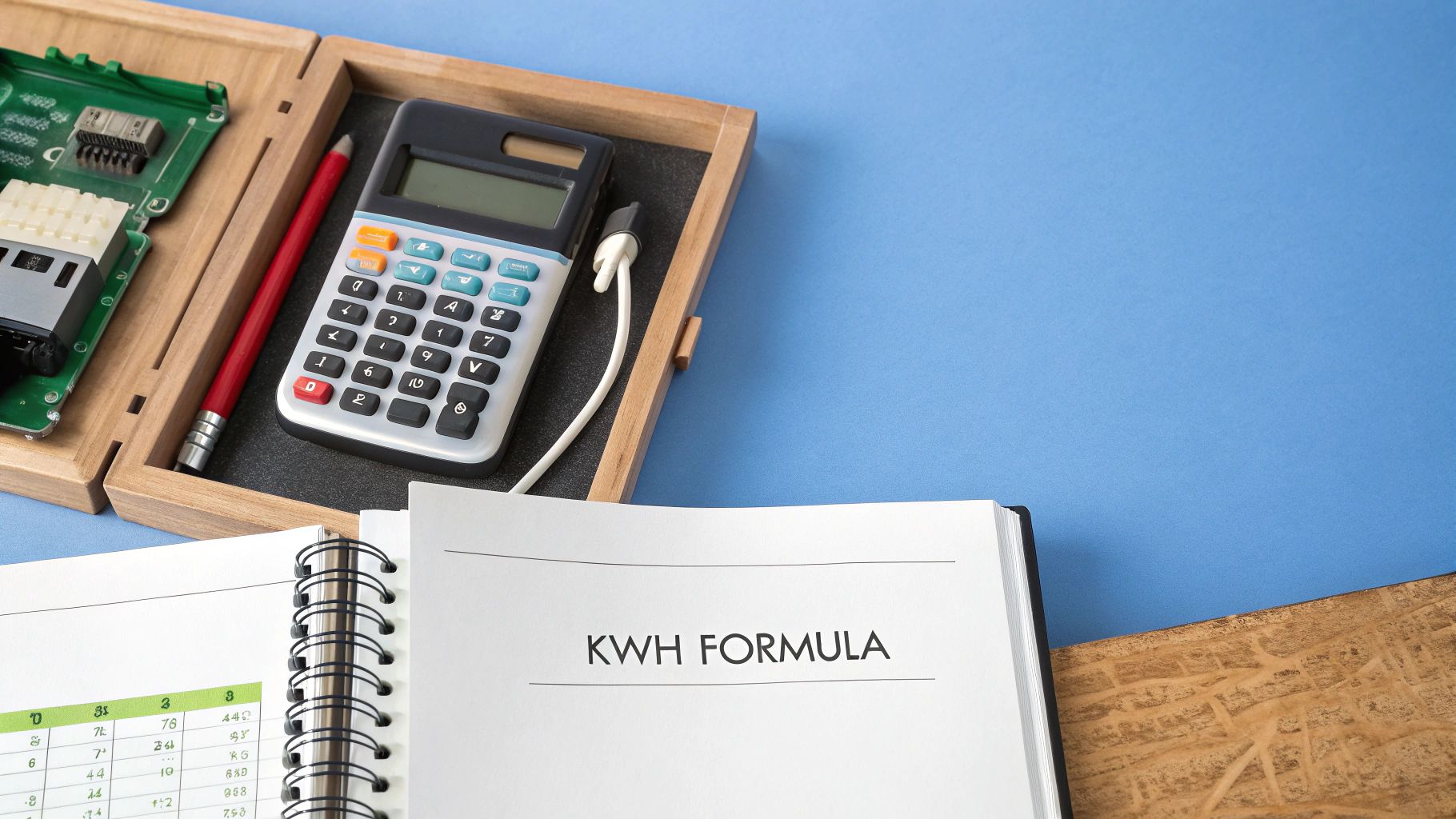
To work out the cost, you’ll need your electricity tariff’s price per kWh . You can usually find this printed on the first or second page of your utility bill, often listed in pence.
Let's say your rate is 22p per kWh . If you used 15 kWh to charge an electric vehicle, the calculation is straightforward: 15 kWh × £0.22 = £3.30 . Simple as that.
Getting a handle on this is crucial for managing business expenses, especially with recent volatility. Historical data shows UK non-domestic electricity prices have shot up from 14.81p per kWh in early 2021 to peaks over 27p per kWh by 2023, creating major cost pressures for businesses everywhere.
Mastering Peak and Off-Peak Tariffs
Many UK energy suppliers offer tariffs with different prices depending on the time of day—something smart consumers and businesses can really take advantage of.
- Peak Hours: This is when electricity is most expensive due to high demand, typically in the late afternoon and early evening.
- Off-Peak Hours: Costs drop significantly overnight when overall demand is much lower, making it the perfect time for energy-intensive tasks like charging an EV.
Shifting your energy use to off-peak times is one of the most powerful ways to slash your bills. For instance, charging an EV overnight could easily cut your costs by more than half compared to plugging in during peak hours. To get a better grip on your spending, you can use an energy utility bill forecaster to predict future costs based on your specific usage patterns.
By scheduling high-consumption activities like EV charging or running a tumble dryer during off-peak hours, you can make a tangible dent in your monthly outgoings.
This strategic approach is also at the heart of the Energy as a Service model, where smart energy management is the key to providing affordable mobile charging solutions.
The Business of Mobile EV Charging
Knowing how to calculate a kilowatt-hour isn't just about trimming your home energy bills; it's the very foundation of a serious commercial opportunity. Mobile EV charging offers a surprisingly straightforward and profitable business model for anyone who can deliver power where it's needed most.
At its heart, the business is about buying electricity at a standard rate and selling it on at a premium. Your profit is simply the margin between what you pay for electricity and the price you charge your customer. By getting a firm grip on the kWh calculation, you can figure out your exact cost per charge and set a retail price that guarantees a healthy return on every call-out. It’s the financial engine that keeps a mobile charging service running.
Building a Profitable Pricing Structure
There are a few effective ways to price your services. Remember, you’re not just selling electricity; you're selling convenience, speed, and peace of mind to a driver who is stranded or just short on time. Your pricing needs to reflect that value.
Two popular models have emerged:
- A Call-Out Fee Plus Per-kWh Rate: This is a solid approach. It covers your operational costs like fuel and time with a flat fee and then you add a profitable margin on the energy you deliver. For example, a £30 call-out fee plus £0.65 per kWh.
- An All-Inclusive Premium Service Charge: For the sake of simplicity, you could offer a single price for a set amount of energy or time. Think along the lines of £55 for a 30-minute rapid charge that delivers around 15 kWh of energy.
The real key to profitability is balancing competitive pricing with a crystal-clear understanding of your costs. You have to accurately calculate the cost of the electricity you use to recharge your mobile units before you can ever figure out the profit from selling it to an EV driver.
A Look at Potential Earnings
Let's walk through a realistic scenario to demonstrate how much money an operator can make. Imagine you pay an average of £0.22 per kWh for the electricity you store in your mobile unit. You decide to set your customer price at £0.70 per kWh , plus a standard £20 call-out fee for every job.
On a typical day, you might complete four call-outs, delivering an average of 20 kWh per vehicle. Here’s how the numbers could break down:
- Total Daily Revenue: (4 charges × £20 call-out fee) + (80 kWh total × £0.70/kWh) = £80 + £56 = £136
- Total Daily Electricity Cost: 80 kWh × £0.22/kWh = £17.60
- Gross Daily Profit: £136 - £17.60 = £118.40
This simple example shows the strong potential for profit, even before you start scaling up operations. For a more detailed breakdown, exploring the economics of mobile EV charging can provide much deeper insights into building a sustainable business model.
Mobile EV Charging Profit Projection
To give you a clearer picture of the earnings potential, the table below maps out a few different daily scenarios for a mobile charging operator. It shows how varying the number of daily jobs and the average charge delivered can impact your bottom line.
| Scenario | Charges per Day | Average kWh per Charge | Total Cost of Electricity | Total Revenue | Daily Profit |
|---|---|---|---|---|---|
| Quiet Day | 2 | 15 kWh | £6.60 | £71.00 | £64.40 |
| Standard Day | 4 | 20 kWh | £17.60 | £136.00 | £118.40 |
| Busy Day | 6 | 25 kWh | £33.00 | £225.00 | £192.00 |
| High Demand | 8 | 20 kWh | £35.20 | £272.00 | £236.80 |
As you can see, even on a slower day, the profit margins are healthy. As your business grows and you complete more jobs, the daily profit increases significantly, highlighting just how scalable this model can be. Mobile charging is not just convenient for drivers; it represents a lucrative opportunity for operators.
Common Calculation Mistakes to Avoid
Even when you have the right formula, a few simple slip-ups can easily throw your figures off, affecting everything from your household budget to a company's bottom line. When it comes to calculating a kilowatt-hour, I’ve seen a few common trip-ups that lead to wildly inaccurate results time and time again.
The most frequent mistake I see is confusing watts with kilowatts. Always, always remember to divide the wattage by 1,000 to convert it into kilowatts before you multiply by the hours of use. A 7,000-watt charger is 7 kW , not 7,000 kW—a mix-up that could be very costly.
Another classic pitfall is forgetting to convert minutes into hours. If a charger runs for 30 minutes, you must use 0.5 hours in your calculation, not 30. Using whole numbers for minutes will massively inflate your final kWh figure and give you a nasty shock when the bill arrives.
Ensuring Accuracy in Your Calculations
Misreading an appliance's power label is also a common issue. Some labels are tricky, showing a range of power draws or listing different figures for various functions. For anything with variable power consumption, like a fridge or an air conditioner, a simple plug-in energy monitor will give you the most precise data you can get.
It's a widespread myth that devices on standby use no power. This "phantom load" can add up significantly over time so it's worth measuring or factoring it into your estimates for a true picture of your energy use.
Understanding these details is vital, especially when you look at the broader context of UK energy trends. Since 2000, electricity use per person has actually dropped by around 30% , reflecting huge gains in efficiency. Getting your kWh calculations right is the key to tracking this progress in your own home or business. You can discover more insights about UK energy consumption trends on enerdata.net.
Got Questions? We've Got Answers
Getting to grips with kilowatt-hours is straightforward but it's natural for a few questions to pop up along the way. Here are some clear answers to the queries we hear most often.
What's The Difference Between A Kilowatt And A Kilowatt-Hour?
Think of it like speed versus distance. A kilowatt (kW) is a measure of power—it’s how much energy a device is using at any single moment, like the speed on a car's speedometer.
A kilowatt-hour (kWh) , on the other hand, is the total amount of energy consumed over a period of time. This is the figure that actually matters on your electricity bill.
How Can I Find An Appliance's Wattage?
Most devices have a small label on the back or bottom that lists their power consumption in watts (W) . It's often near the voltage and other electrical information.
If you can't find it, the user manual is your next best bet. Failing that, a quick online search for the model number usually does the trick. For gadgets with variable power modes (like a laptop), a plug-in energy monitor will give you the most accurate real-world reading.
Is A Mobile EV Charging Service Profitable In The UK?
Yes, it absolutely can be. The business model is refreshingly simple: you buy electricity at a standard rate and sell it at a premium to EV drivers who need a convenient top-up. The advantage of mobile charging is that you can reach customers anywhere, providing a vital service that static chargers cannot.
Your profit comes from this markup, plus any service or call-out fees you decide to add. Like any business, success hinges on running an efficient operation and setting a smart pricing strategy that reflects the value you're offering.
Mobile EV charging is one of the fastest-growing markets in the UK. To see how your business can get ahead of the curve, get in touch with ZAPME and explore our range of mobile charging solutions at https://www.zapme.biz.

